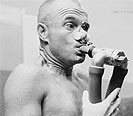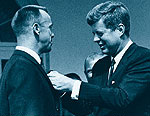Starred entries signify events related to The Right Stuff.
1903
- December 17: Orville Wright makes the first controlled flight at Kill Devil Hills, N.C.
1915
- The National Advisory Committee for Aeronautics (NACA) is formed by Act of Congress to promote research into flight and aviation.
1926
- Robert Goddard launches the world’s first liquid-fueled rocket at Auburn, Mass. Research in rocketry continues throughout Europe, the United States and the Soviet Union.
1942
- October 3: A test flight of the German V-2 missile reaches space (100 km above Earth’s surface).
1945
- March 16: NACA commissions Bell Aircraft to design and build a supersonic test aircraft.
- May 8: Germany surrenders to the Allies at the end of World War II. Subsequently, many scientists who surrendered to or were captured by the Allies are recruited by the United States in “Operation Paperclip.”
1947
- September 18: The National Security Act of 1947 separates the United States Air Force from the United States Army.
- *October 14: Chuck Yeager pilots the Bell X-1, the first manned aircraft to reach supersonic speed.
1953
- The International Council of Scientific Unions declares the period between July 1957 and December 1958 to be the International Polar Year (later the International Geophysical Year, or IGY) and in 1954 invites nations to develop satellites to map the globe.
- January 20: Dwight D. Eisenhower assumes office as president. His Cold War strategy hinges on technological advancement and air superiority, and strategic uses of space.
- December 3: Test pilot Scott Crossfield passes Mach 2 (a speed of 1,291 miles per hour) in a Douglas D-558 Skyrocket.
1955
- August: The US Navy’s Project Vanguard begins development of an artificial satellite.
1957
- October 4: The Soviet Union launches Sputnik 1, the first artificial satellite in space. One month later (November 3), Sputnik 2 is launched, carrying the dog Laika, the first animal in orbit.
1958
- February 1: The United States launches Explorer 1, the first American satellite to successfully enter orbit.
- July 29: An Act of Congress creates the National Aeronautics and Space Administration (NASA) from NACA and portions of the Army Ballistic Missile Agency (ABMA) and the Naval Research Laboratory.
1958-63
- *Project Mercury, intended to prove that human spaceflight is possible.
1959
- *April 9: Seven astronauts (the “Mercury 7”) are chosen by NASA from a field of 69. A group of 13 women (the “Mercury 13”) is also evaluated by one of the physicians at NASA in 1960, but the program is terminated.
- June 8: Pilot Scott Crossfield tests the first flight of the X-15 at Edwards. He later flies the first powered flight of the X-15 on September 17. Thirteen X-15 flights fly over 50 miles high, enough that they qualify the pilots for astronaut wings from NASA.
1961
- January 20: John F. Kennedy assumes office as president.
- John F. Kennedy awards astronaut Alan Shepard the NASA Distinguished Service Medal May 8, 1961
- *April 12: Russian cosmonaut Yuri Gagarin orbits Earth aboard Vostok 1, becoming the first human in space. The United States shortly follows, launching Alan Shepard aboard Freedom 7 on May 5; however, Shepard does not achieve orbit.
- May 25: President Kennedy addresses Congress, challenging the United States to send a mission to the moon and back by 1970.
- *July 21: Virgil “Gus” Grissom is launched in Liberty Bell 7, but does not achieve orbit.
1962
- *February 20: John Glenn successfully orbits Earth aboard Friendship 7.
- *May 4: Scott Carpenter orbits Earth aboard Aurora 7.
- *October 3: Walter Schirra orbits Earth aboard Sigma 7.
1963
- *May 15: Gordon Cooper orbits Earth aboard Faith 7. This is the last flight of Project Mercury.
1964-66
- Project Gemini; 10 manned flights launch between 1965-66.
1961-75
- Apollo Program; succeeds in landing six missions on the moon.
1967
- January 27: Apollo 1 is lost in an explosion on the launch pad during a test with all hands.
- December 23-25: Apollo 8 orbits the moon.
1969
- July 20: Apollo 11 successfully lands on the moon.
1971
- April 19: Salyut 1, the first manned space station, is launched by the Soviet Union. Six more Salyut stations follow. Portions of two more planned missions evolve into Mir and portions of the International Space Station (ISS).
1973-74
- Skylab is launched and serves as the first American space station. Its orbit proves unstable, and it eventually falls to Earth in 1979.
1975
- July 17: Apollo-Soyuz Test Project: An Apollo craft and a Soyuz craft dock in space.
1972-2011
- Space Shuttle Program
1981
- April 12: Shuttle Columbia is launched.
1986
- January 28: Shuttle Challenger is lost at takeoff with all hands.
- February 19: The Soviet Union launches the Mir station, continuously occupied from September 1989 to August 1999. Shuttles begin docking with Mir in 1995.
1991
- The Soviet Union dissolves. Most space operations are assumed by Russia.
1993-present
- International Space Station Project, a joint effort and combination of previous Russian, NASA and European Space Agency projects. Assembly begins in 1998 with the launch of the first American and Russian sections, and the station is continuously occupied from November 2, 2000 forward.
2001
- March 23: Mir is deorbited and breaks up over the South Pacific.
2003
- February 1: Shuttle Columbia is lost upon reentry with all hands.
2011
- July 21: Space shuttle Atlantis returns to Earth, marking the end of the space shuttle program.
2012
- August 5: The Curiosity rover lands on Mars nine months after its launch. Its mission is to study whether conditions on Mars have been favorable for microbial life.
Content last updated: October 31, 2008



